When it comes to home financing in India, most buyers focus on traditional tools like bank loans, savings, or EMIs. However, there is one powerful yet underutilised financial asset that can significantly support your home-buying journey: your Public Provident Fund (PPF) account. Although you cannot “pledge” or “mortgage” your PPF balance for a home loan, the funds accumulated in your PPF can play a strategic role in loan approval, down payment planning, EMI management, and long-term interest optimisation.
This blog takes a deep, structured, and practical approach to understanding exactly how to apply for a home loan with support from your PPF account, how to plan withdrawals, which rules matter, how to combine PPF with other financing options, and how to avoid common mistakes. Every section is designed to help you use your PPF balance intelligently and confidently while purchasing your dream home.
Also Read: Home Loan Interest Rates 2025: Fixed vs Floating & When to Switch
What Is a PPF Account and How Does It Relate to Home Loans?

A Public Provident Fund (PPF) is a long-term government-backed savings scheme with a 15-year lock-in, offering tax-free returns and one of the safest interest structures in India. While banks do not allow you to use PPF as collateral for a home loan, PPF can still assist your home loan application through partial withdrawals, loan eligibility support, and improved financial profiling.
Your accumulated balance in PPF can be used for down payments, early EMI repayments, part-prepayments, or even reducing your overall loan tenure. This makes PPF an indirect yet highly effective financing tool.
What Is the Eligibility for Home Loan Using Public Provident Fund?

Banks do not have a special category called “PPF-based home loans.” Instead, they consider PPF withdrawals or maturity proceeds as a legitimate source of funds. Your eligibility depends on three primary criteria:
- The age of your PPF account
- The amount available for withdrawal
- Your income stability and repayment capacity
If your PPF account has crossed at least 6 financial years, you may be eligible for partial withdrawals. If it has matured (15 years), you may withdraw the entire amount and use it for your home purchase.
What Is the Step-by-Step Guide to Home Loan with PPF Savings?

A systematic process ensures the smoothest experience. Here is the complete guide:
Step 1: Assess your PPF balance
Check how much is available for withdrawal or loan. Withdrawals are allowed after 6 years, while advances against PPF are allowed between years 3 to 6.
Step 2: Decide your home financing strategy
Use PPF funds for down payment, stamp duty, initial EMI buffer, or part-prepayment.
Step 3: File a withdrawal request
Submit Form C to the bank or post office to withdraw PPF funds. Ensure KYC documents match your loan application.
Step 4: Apply for the home loan
Use your PPF withdrawal proof as part of your funding declaration.
Step 5: Submit all documents together
This strengthens your financial case and increases approval chances.
Step 6: Use PPF wisely post-loan
Continue contributing to PPF for tax-free savings and potential prepayments later.
Also Read: How CIBIL Score Affects Your Home Loan Approval in 2025
What Are the Benefits of Using PPF for Home Loan Down Payment?

Using your PPF balance for a down payment offers several strategic advantages:
- Reduces the home loan amount you need
- Helps you get better interest rates from banks
- Improves your EMI affordability score
- Reduces long-term interest burden significantly
- Strengthens your financial stability from the bank’s perspective
By using a tax-free and high-interest corpus, you minimise reliance on costly borrowed funds.
What Are the Common Mistakes to Avoid When Using PPF for Home Loans?

Most borrowers make errors that reduce the effectiveness of their PPF support:
- Withdrawing the entire PPF amount prematurely
- Not considering how interest income will reduce after withdrawal
- Using PPF funds only for a bigger down payment instead of EMI planning
- Violating withdrawal rules and delaying home loan approval
- Not maintaining minimum balances post-withdrawal
Avoiding these mistakes ensures that your financial plan remains stable and long-term growth is protected.
What Documents Are Required for Home Loan Application with PPF Funds?

To ensure seamless loan approval, prepare the following documents:
- PPF withdrawal form (Form C or maturity withdrawal confirmation)
- Updated PPF passbook reflecting the withdrawal
- KYC documents
- Salary slips or income tax returns
- Bank statements for at least six months
- Property documents required by the lender
Submitting all these documents together avoids unnecessary delays.
Also Read: Credit Score for Home Loans: Fast Fixes to Jump 50+ Points
How Do PPF Interest Rates Impact Your Home Loan Strategy?

PPF interest rates are revised quarterly, but historically remain above typical bank fixed deposit rates. A higher PPF rate means more long-term compounding value, so withdrawing too much can reduce your wealth-building potential.
Plan withdrawals in a way that:
- You use only what is genuinely necessary
- You retain compounding benefits for future prepayments
- You keep contributing to your PPF even after taking a home loan
This ensures balanced financial planning.
How to Leverage PPF for Home Loan Approval?
PPF balances and disciplined contributions help build financial trust. Banks view your PPF history as a sign of stability, long-term planning, and savings consistency. You can leverage PPF in the following ways:
- Show PPF balance as part of your net worth
- Use PPF withdrawals to reduce loan-to-value ratio
- Demonstrate your capacity for future prepayments
- Improve your creditworthiness by maintaining low overall liabilities
This significantly boosts your approval chances.
How Does Comparing PPF-Based Home Loans with Other Financing Options Help?
Before using your PPF balance, compare it with alternatives:
- Bank Fixed Deposits
Lower post-tax returns compared to PPF.
- Personal Loans
Higher interest rates; ideally avoid using them for down payments.
- Liquid Mutual Funds
More flexible but riskier than PPF.
- Family Borrowing
May be interest-free but affects personal relationships.
- Salary Advance
Not adequate for down payments in most cases.
PPF offers tax-free growth and the highest safety, making it the most reliable support tool.
What Are the Tax Implications of Using PPF for Home Loan Repayments?

PPF withdrawals remain tax-free at all times. Using the amount for home loan repayment does not affect its tax status. However, remember:
- You cannot claim 80C benefits on the withdrawn PPF amount
- You can still claim home loan tax benefits under 80C and 24(b) as usual
This ensures taxation remains simple and beneficial.
Also Read: What To Do If Home Loan EMI Bounces in India in 2025?
What Are Important Tips for Applying for a Home Loan with PPF Balance?

To maximise benefits, follow these tips:
- Plan withdrawals ahead of time
- Continue contributing to PPF even after using some funds
- Avoid breaking long-term compounding unnecessarily
- Use PPF only for essential home-loan needs
- Keep your PPF passbook updated and in sync with your KYC details
Following these tips ensures a smoother journey.
How Can PPF Savings Help Secure a Mortgage?

Using PPF savings strengthens your financial profile and overall creditworthiness. The presence of a long-term, tax-free, and government-backed savings instrument shows the bank that you are financially disciplined and stable.
Hence, lenders view your profile more favorably and may even offer better interest rates.
Also Read: Home Loan Subsidy 2024-25: Criteria, Benefits, Process & More
Complete Guide to Home Loan Application via PPF

A complete guide requires considering:
- Withdrawal rules
- Loan-versus-withdrawal strategy
- Impact on long-term returns
- Bank eligibility criteria
- Documentation requirements
- Tax implications
- EMI planning
- Mistake avoidance
- Future financial consistency
When all these elements come together, your PPF account becomes an efficient support mechanism for your home purchase.
Conclusion
Buying a home is one of the biggest financial commitments in an individual’s life, and using your PPF account intelligently can give you a major advantage. Whether you plan to use partial withdrawals for a down payment, reduce your EMI burden, strengthen your loan eligibility, or manage long-term repayment better, the PPF remains one of the most reliable tools available to Indian homebuyers.
With careful planning, strict adherence to withdrawal rules, and smart integration of PPF benefits into your loan strategy, you can significantly reduce your interest burden and improve your financial health. For homebuyers seeking clarity, simplicity, and long-term financial security, using PPF as part of your home loan approach is both practical and powerful.
At Housiey, we simplify home-buying decisions with transparent information, clear guidance, and complete support.
If you want to dive deeper into smart property investment planning, make sure you read our detailed blog on why you should invest in the second home market in 2025–2026.
FAQs
When it comes to home financing in India, most buyers focus on traditional tools like bank loans, savings, or EMIs. However, there is one powerful yet underutilised financial asset that can significantly support your home-buying journey: your Public Provident Fund (PPF) account. Although you cannot “pledge” or “mortgage” your PPF balance for a home loan, the funds accumulated in your PPF can play a strategic role in loan approval, down payment planning, EMI management, and long-term interest optimisation.
This blog takes a deep, structured, and practical approach to understanding exactly how to apply for a home loan with support from your PPF account, how to plan withdrawals, which rules matter, how to combine PPF with other financing options, and how to avoid common mistakes. Every section is designed to help you use your PPF balance intelligently and confidently while purchasing your dream home.
Also Read: Home Loan Interest Rates 2025: Fixed vs Floating & When to Switch
What Is a PPF Account and How Does It Relate to Home Loans?

A Public Provident Fund (PPF) is a long-term government-backed savings scheme with a 15-year lock-in, offering tax-free returns and one of the safest interest structures in India. While banks do not allow you to use PPF as collateral for a home loan, PPF can still assist your home loan application through partial withdrawals, loan eligibility support, and improved financial profiling.
Your accumulated balance in PPF can be used for down payments, early EMI repayments, part-prepayments, or even reducing your overall loan tenure. This makes PPF an indirect yet highly effective financing tool.
What Is the Eligibility for Home Loan Using Public Provident Fund?

Banks do not have a special category called “PPF-based home loans.” Instead, they consider PPF withdrawals or maturity proceeds as a legitimate source of funds. Your eligibility depends on three primary criteria:
- The age of your PPF account
- The amount available for withdrawal
- Your income stability and repayment capacity
If your PPF account has crossed at least 6 financial years, you may be eligible for partial withdrawals. If it has matured (15 years), you may withdraw the entire amount and use it for your home purchase.
What Is the Step-by-Step Guide to Home Loan with PPF Savings?

A systematic process ensures the smoothest experience. Here is the complete guide:
Step 1: Assess your PPF balance
Check how much is available for withdrawal or loan. Withdrawals are allowed after 6 years, while advances against PPF are allowed between years 3 to 6.
Step 2: Decide your home financing strategy
Use PPF funds for down payment, stamp duty, initial EMI buffer, or part-prepayment.
Step 3: File a withdrawal request
Submit Form C to the bank or post office to withdraw PPF funds. Ensure KYC documents match your loan application.
Step 4: Apply for the home loan
Use your PPF withdrawal proof as part of your funding declaration.
Step 5: Submit all documents together
This strengthens your financial case and increases approval chances.
Step 6: Use PPF wisely post-loan
Continue contributing to PPF for tax-free savings and potential prepayments later.
Also Read: How CIBIL Score Affects Your Home Loan Approval in 2025
What Are the Benefits of Using PPF for Home Loan Down Payment?

Using your PPF balance for a down payment offers several strategic advantages:
- Reduces the home loan amount you need
- Helps you get better interest rates from banks
- Improves your EMI affordability score
- Reduces long-term interest burden significantly
- Strengthens your financial stability from the bank’s perspective
By using a tax-free and high-interest corpus, you minimise reliance on costly borrowed funds.
What Are the Common Mistakes to Avoid When Using PPF for Home Loans?

Most borrowers make errors that reduce the effectiveness of their PPF support:
- Withdrawing the entire PPF amount prematurely
- Not considering how interest income will reduce after withdrawal
- Using PPF funds only for a bigger down payment instead of EMI planning
- Violating withdrawal rules and delaying home loan approval
- Not maintaining minimum balances post-withdrawal
Avoiding these mistakes ensures that your financial plan remains stable and long-term growth is protected.
What Documents Are Required for Home Loan Application with PPF Funds?

To ensure seamless loan approval, prepare the following documents:
- PPF withdrawal form (Form C or maturity withdrawal confirmation)
- Updated PPF passbook reflecting the withdrawal
- KYC documents
- Salary slips or income tax returns
- Bank statements for at least six months
- Property documents required by the lender
Submitting all these documents together avoids unnecessary delays.
Also Read: Credit Score for Home Loans: Fast Fixes to Jump 50+ Points
How Do PPF Interest Rates Impact Your Home Loan Strategy?

PPF interest rates are revised quarterly, but historically remain above typical bank fixed deposit rates. A higher PPF rate means more long-term compounding value, so withdrawing too much can reduce your wealth-building potential.
Plan withdrawals in a way that:
- You use only what is genuinely necessary
- You retain compounding benefits for future prepayments
- You keep contributing to your PPF even after taking a home loan
This ensures balanced financial planning.
How to Leverage PPF for Home Loan Approval?
PPF balances and disciplined contributions help build financial trust. Banks view your PPF history as a sign of stability, long-term planning, and savings consistency. You can leverage PPF in the following ways:
- Show PPF balance as part of your net worth
- Use PPF withdrawals to reduce loan-to-value ratio
- Demonstrate your capacity for future prepayments
- Improve your creditworthiness by maintaining low overall liabilities
This significantly boosts your approval chances.
How Does Comparing PPF-Based Home Loans with Other Financing Options Help?
Before using your PPF balance, compare it with alternatives:
- Bank Fixed Deposits
Lower post-tax returns compared to PPF.
- Personal Loans
Higher interest rates; ideally avoid using them for down payments.
- Liquid Mutual Funds
More flexible but riskier than PPF.
- Family Borrowing
May be interest-free but affects personal relationships.
- Salary Advance
Not adequate for down payments in most cases.
PPF offers tax-free growth and the highest safety, making it the most reliable support tool.
What Are the Tax Implications of Using PPF for Home Loan Repayments?

PPF withdrawals remain tax-free at all times. Using the amount for home loan repayment does not affect its tax status. However, remember:
- You cannot claim 80C benefits on the withdrawn PPF amount
- You can still claim home loan tax benefits under 80C and 24(b) as usual
This ensures taxation remains simple and beneficial.
Also Read: What To Do If Home Loan EMI Bounces in India in 2025?
What Are Important Tips for Applying for a Home Loan with PPF Balance?

To maximise benefits, follow these tips:
- Plan withdrawals ahead of time
- Continue contributing to PPF even after using some funds
- Avoid breaking long-term compounding unnecessarily
- Use PPF only for essential home-loan needs
- Keep your PPF passbook updated and in sync with your KYC details
Following these tips ensures a smoother journey.
How Can PPF Savings Help Secure a Mortgage?

Using PPF savings strengthens your financial profile and overall creditworthiness. The presence of a long-term, tax-free, and government-backed savings instrument shows the bank that you are financially disciplined and stable.
Hence, lenders view your profile more favorably and may even offer better interest rates.
Also Read: Home Loan Subsidy 2024-25: Criteria, Benefits, Process & More
Complete Guide to Home Loan Application via PPF

A complete guide requires considering:
- Withdrawal rules
- Loan-versus-withdrawal strategy
- Impact on long-term returns
- Bank eligibility criteria
- Documentation requirements
- Tax implications
- EMI planning
- Mistake avoidance
- Future financial consistency
When all these elements come together, your PPF account becomes an efficient support mechanism for your home purchase.
Conclusion
Buying a home is one of the biggest financial commitments in an individual’s life, and using your PPF account intelligently can give you a major advantage. Whether you plan to use partial withdrawals for a down payment, reduce your EMI burden, strengthen your loan eligibility, or manage long-term repayment better, the PPF remains one of the most reliable tools available to Indian homebuyers.
With careful planning, strict adherence to withdrawal rules, and smart integration of PPF benefits into your loan strategy, you can significantly reduce your interest burden and improve your financial health. For homebuyers seeking clarity, simplicity, and long-term financial security, using PPF as part of your home loan approach is both practical and powerful.
At Housiey, we simplify home-buying decisions with transparent information, clear guidance, and complete support.
If you want to dive deeper into smart property investment planning, make sure you read our detailed blog on why you should invest in the second home market in 2025–2026.
FAQs

















